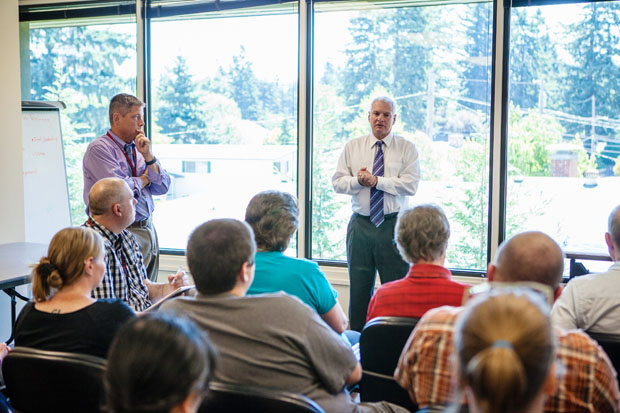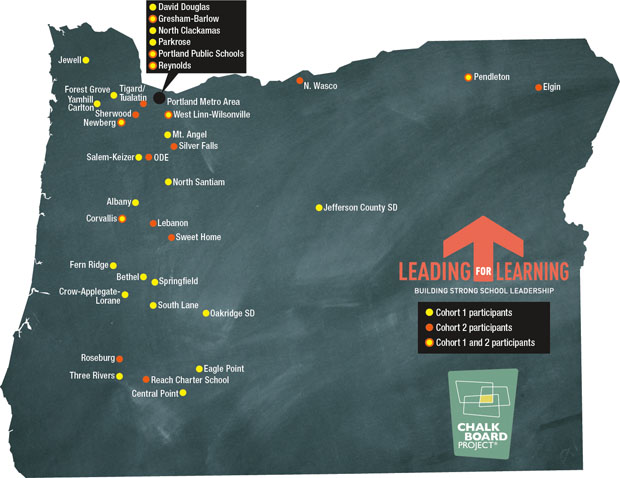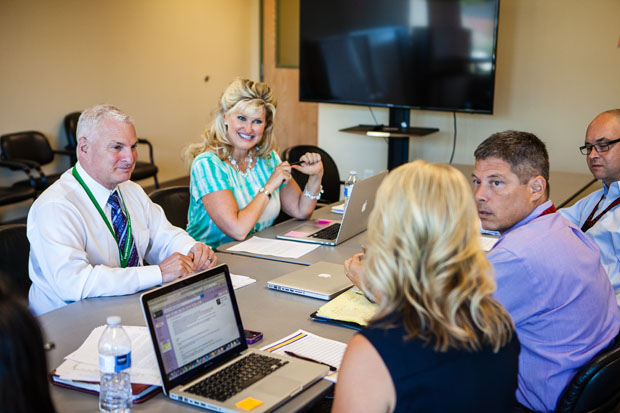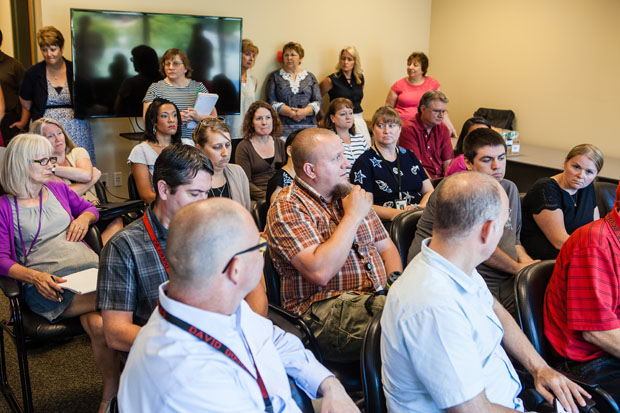BY JON SHADEL
Transforming the culture of Oregon’s educational leadership.
BY JON SHADEL
Transforming the culture of Oregon’s educational leadership

Don Grotting, superintendent of David Douglas School District, leading district staff in preparation for the upcoming school year.
{pullquote}There’s a growing body of evidence around the importance of effective school leadership on growth in student achievement, and it’s especially important for the underperforming schools. {/pullquote}
If someone had told Krista Parent 30 years ago she’d spend the next three decades of her career in the same school district, she would have laughed in disbelief.
In 1985 Parent, a new graduate of the University of Oregon, joined the ranks of teachers in Oregon’s South Lane School District. She started her teaching career at Lincoln Junior High before moving to Cottage Grove High School as an assistant principal. By 2001, Parent was superintendent of the district, a position she has excelled in for the last 14 years. She remains the only Oregon superintendent to receive the National Superintendent of the Year award from the American Association of School Administrators.
Parent didn’t plan a career in school administration. “I never really intended to be a superintendent,” she laughs. “To be quite honest, I didn’t really know what they did,” she says of her early years on the job. However, her experience working at all levels of Oregon’s school system has granted her unparalleled insight into the challenges facing students of all backgrounds and strategies for improving instruction across the board.
Parent is one of a growing number of education leaders who are concerned about the training and professional development Oregon’s principals and superintendents receive. In recent years, the job responsibilities for principals and superintendents have undergone a dramatic change, shifting away from managerial duties and toward innovation in instruction. Training, unfortunately, has not kept pace with the job description.
But Parent believes Chalkboard Project is on track to change this.
Chalkboard Project — a nonprofit organization dedicated to making Oregon’s schools among the best in the country — is tackling these challenges by developing and investing seed money to launch Leading for Learning, a set of two leadership training programs for current and aspiring leaders. The goal is to boost student outcomes by building stronger school leadership.

School districts participating in Leading for Learning; non district participants include Reach Charter School and the Oregon Department of Education.
Leading for Learning was born out of the recommendations developed by the Distinguished Leaders Council (DLC), a cohort of educational leaders drawn from all corners of the state. This group, which included Parent and 14 other leaders, examined a growing body of research that indicates school leaders play an essential role in raising student achievement in schools, with principals accounting for up to 25% of a school’s total impact on student achievement.
“We came together to determine how we could address gaps in leadership preparation and help current leaders become stronger,” Parent says, “and we found that the districts that are doing really well have school leaders that are focused on how they improve student learning.”
In other words: The highest-achieving schools are led by principals and central office staff who prioritize instructional practices first, and tend to managerial and administrative duties second.
Despite these findings, relatively little had been done to strengthen school leadership preparation and support in Oregon until Chalkboard Project implemented Leading for Learning in 2015, an initiative that Sue Hildick, president, describes as an extension of the work being done with two of Chalkboard Project’s other successful initiatives: TeachOregon and CLASS Project.
“Working with us in CLASS, leaders in classrooms describe the program as transformational,” says Hildick, explaining how CLASS flattens school leadership and gives teachers a greater voice in teaching and learning decisions in their schools.

Coaching and mentoring are key priorities for instructional leaders.
Aiming to replicate the success of these two teacher-focused programs, Hildick says Leading for Learning is an opportunity to further increase awareness among Oregon’s school leaders, a step she believes crucial to raising the bar of student achievement. “We now view CLASS as a culture-changing exercise school districts can go through, if they want to, and expect a lot of great change,” she says. “With Leading for Learning, we’re adding another piece to that portfolio, which, hopefully, should equip leaders to drive that change more deeply.”
Leading for Learning is best understood as a duo of training programs addressing two key challenges school leaders face. The first program, Current Leaders, was implemented in January 2015 and aims to build central office capacity to better support principals and their schools. The second, Aspiring Leaders, is still in the design phase and intends to strengthen the preparation programs for new leaders and increase recruitment of historically underrepresented minorities for such positions.
Chalkboard Project partnered with the Center for Educational Leadership at the University of Washington to enhance the abilities of superintendents and central office staff to support principals in improving instructional leadership practices. The program offers participants 18 to 24 months of training — incorporating both seminar and practicum components — that provide support to assess school needs and design effective turnaround strategies.
So far the response from school administrators has been overwhelmingly positive. Chalkboard Project had planned for 50 participants but had to expand the first class to a total of 71 to meet demand. (A second cohort begins the program in August, making the total number of participants 118.) The participants come from 35 school districts across the state, representing a cross section of Oregon’s education system, with small, rural district leaders collaborating with large, urban ones.
Don Grotting, superintendent of Portland’s David Douglas School District, has only been participating in the Current Leaders cohort since January. But he’s already incorporating what he’s learned into the planning for next year.
“This program has made us prioritize what’s most important — giving us the tools we need, like better time management and improved teacher evaluations, so we can focus on becoming better instructional leaders,” says Grotting. As he plans for the next school year, he insists everything from district meeting schedules to principal schedules will change so that the majority of in-person discussions will focus on evaluating and improving instruction in his schools.

Still, knowing what good leadership is and putting it into practice are two different things. “We’re talking about how we can better support principals and how principals can better support teachers,” says Grotting. “The challenge is that this is a different way of being district administrators. It’s really more of a coaching model — using the evidence you’re able to gather through collaboration to improve instruction. And let me say: that’s hard.”
Sally Storm, superintendent at Fern Ridge School District and member of the DLC, recognizes the challenges but sees great potential for the Leading for Learning program to improve instruction in school districts all across the state. “You can’t help schools that have mediocre principals. That’s how important they are to student achievement,” Storm says, “and this program helps build the capacity for superintendents to strengthen the leadership skills of principals.”
She points to the practicum component of the Current Leaders program as an example of its potential. In practicum, a group of superintendents from the cohort visit a host school to observe the principal and teachers while also assessing the quality of instruction. Once the issue has been defined, the group works together to devise a strategy to help the principal remedy it. This evidence-based model — built on the findings from research on effective educational leadership — represents a significant cultural shift in Oregon’s education leadership, says Storm.
Chalkboard Project hopes to further transform the culture of school leadership with the launch of the Aspiring Leaders program. The plan is to provide future school leaders with meaningful training and relevant course work that reflects the challenges they will face on the job.
Iton Udosenata, a recently appointed principal in the Cottage Grove High School and a member of the DLC, recognizes that strengthening the pipeline for new Oregon principals and retaining individuals from historically underrepresented minorities remains a key challenge in closing the achievement gap for all students. He believes a program like Aspiring Leaders will be necessary to help prepare new principals for the realities of the job.
“Principals wear a lot of hats,” says Udosenata. “In the 65 hours a week you’re on the job, you’re often focusing a lot of your attention on fire drills, upset parents, supervision and any number of urgent concerns — and then instruction.” This lack of priority, he says, is a problem of practice, and more rigorous and selective licensure preparation programs for teachers aspiring to enter school administration are needed to address it.
Added together, Leading for Learning’s two training programs have the potential to strengthen instruction, close student achievement gaps and make Oregon one of the best places in the country to be a school leader. But while Chalkboard Project has invested significantly in accelerating the program, full implementation will require additional funding. This is an area where Chalkboard Project believes the state — which added $2 million in funding for school leadership in the 2015 legislative session — should take the lead.
“From my perspective, we’re offering the best training in the country for school leaders, and it shows that people are eager to see us drive change for school leadership,” Hildick says. “I’m encouraged by the response so far. I believe this will be yet another tool for accelerating increased student achievement, our number-one goal.”



